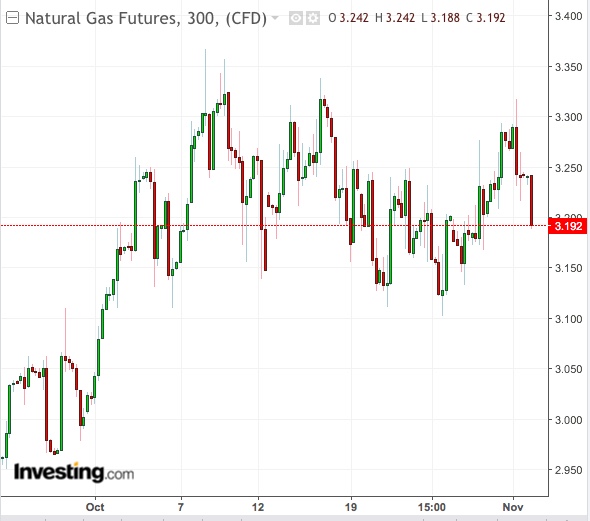The margin of error is tightening for natural gas bulls.
The market’s long-running $3 price could soon be challenged if real cold weather remains an unfulfilled promise on a backdrop of unrelenting record high production.
“Trust is returning in the ability of robust supply to cover any unexpected demand,” Daniel Myers, gas analyst at Gelber & Associates in Texas, wrote in a market commentary Thursday.
“It is still unclear when it will be sufficiently cold for the switch to net storage withdrawals to occur. Strong production and a chance for milder weather in the middle of the month could leave the market waffling between marginal injections and withdrawals.”

Investors and traders long the natural gas market have pushed futures on the New York Mercantile Exchange to above the $3 per million metric British thermal units (mmBtu) in late September, and have managed to keep them at that psychologically-important level since, despite overwhelming levels of output—also helped by a late bout of summer heat that forced more gas to be burnt to keep air-conditioners going and not stored in underground caverns ahead of winter.
Still Waiting For The Real Cold
In place of that late blast of heat is now a mixed weather, with intermittent peaks of cold that have reached 45 degrees Farenheit (7 Celcius) and below.
According to Reuters, there were 89 heating degree days (HDDs) last week, compared with 47 HDDs in the same week a year ago and a 30-year normal of 67HDDs for the period. HDDs measure the number of degrees a day's average temperature is below 65 degrees and is used to estimate demand to heat homes and businesses.
While the HDD readings for the last two weeks were above normal levels, to keep the market at above $3 per mmBtu amid the record high production, even more gas has to be burnt each week, analysts said.
US dry natural gas production is expected to rise to an all-time high of 82.67 bcf a day in 2018 from 74.77 bcf per day in 2017, according to government forecasts.
According to analysts, gas in storage is currently adequate to heat an average winter, but an extremely cold event could leave the market severely undersupplied, forcing utility companies to depend on coal as an alternative fuel source.
Gas storage for last week closed at 3.143 trillion cubic feet, after an injection of 48 billion cubic feet (bcf) that came in just below the forecast rise of 51 bcf. Traders viewed the higher injection as still below the five-year norm of 62 bcf. NYMEX’s front-month gas contract was range bound on Thursday after the release of the latest injection number, before settling slightly down, losing 2.4 cents to $3.237 per mmBtu.
Inventory Snapshot Priced Into Market
“The market had already priced-in a relatively small addition into this week’s expectations,” said Myers.
He said another two above-average injections in the next couple of weeks could put the $3 level under further stress, although the norm by mid-November would be for cold weather of 45 Farenheit and below.
Dominick Chirichella of the Energy Management Institute in New York said the 8-14 day weather forecast models were beginning to turn more supportive for heating, and that usually heralded the start of more consistently cold weather. He added
“The current forecast is showing a reappearance and widening of below normal temperatures over most of the country with above normal temperatures projected in a small area on both coasts.”
“The call on NatGas for heating related demand should start to approach normal for this time of the year and during this forecast period.”
